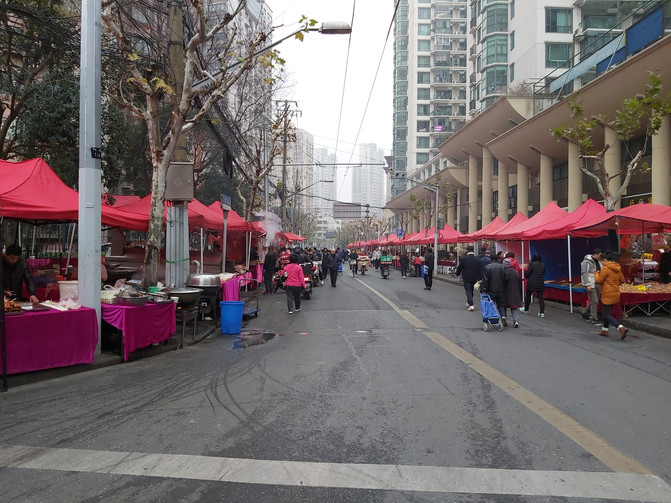On the weekly Main Ma Day, a must-miss opportunity to taste the most authentic Xinjiang cuisine-a visit to the Macau Road Market of Huxi Mosque
On the weekly Main Ma Day, a must-miss opportunity to taste the most authentic Xinjiang cuisine-a visit to the Macau Road Market of Huxi Mosque
1. About Macau Road Muslim Market
On January 2, 2020, when I was visiting the Huxi Mosque, a female Mu Min in the canteen told me that there was a Muslim market at the junction of Changde Road, Macau Road, just a few steps away from the temple. Stamps are set up all day on the main Ma Day every Friday, starting from 6 a.m. and continuing to around 4 p.m. This market has existed for more than 20 years and has never been known to outsiders. Since the broadcast of the program "Gashu Lake"(pronounced "Gayuren" in Shanghai dialect, from the English word "Gossip"), more people have known about it and it has become lively.
2. About the main hemp day
According to Muslim custom, every Friday is Main Ma Day. According to the teachings, Main Ma Day must go to local or nearby mosques to attend Main Ma Day worship. In addition, there are also some sacred deeds (i.e., the words and deeds of Holy Prophet Mohammed) on the main day, such as satirizing the Koran (the Cave Sura), bathing and purifying the body (washing a large bath), wearing beautiful incense, cutting short nails, and shortening beards, etc.
Muslims pray five times a day. Zhuma Day is a seven-day gathering day, which can be understood as one of the seven days. Of course, there are larger prayers, which are the festival prayers held twice a year, the Eid al-Fitr and Eid al-Adha.
There was no custom of setting up stalls to do business or going to markets to purchase goods on Zhuma Day. These were all started when businessmen saw more people gathered in one place and took the opportunity to make profits from doing business.
After the original great prayer, Muslims gathered together to chat and eat, which led to the birth and prosperity of the market.
3. Visiting and tasting the Macau Road Market on Main Day
On Friday, January 3, 2020, which is the main Muslim day, before 8 a.m., I visited the Macau Road Market next to the Huxi Muslim and tasted Xinjiang cuisine.

































The first thing to taste was the beef fried buns and beef pot stickers from this stall. The taste is really good, better than Shanghai Yixinzhai and Yang Tongxing's.
The beef fried buns are soft in skin, full of stuffing, juicy and fresh in taste. Beef pot stickers are also delicious, the same is true.




This stall owner is very good at doing business. He is full of smiles and refuses to give in. He always says that I only earn one yuan per catty.




Each pouch is much larger than a human head.

This delicacy is called noodles and lungs. I didn't taste it this time, but I will have the opportunity to try it next time.

Xinjiang is rich in cattle and sheep and is one of my country's major animal husbandry bases. Using sheep's internal organs as raw materials, it can also be cooked to produce delicious food. Rice intestines and face lungs are representatives of them.






The second thing I tasted was the Xinjiang-flavor Napoleon in this stall. The left and right snacks in this stall were all 50 yuan per catty (500 grams). I weighed a piece of Napoleon for 11 yuan. The taste was also very good. It was not as heavy as the aroma in the pastry shop (It may be related to additives), and the taste was slightly harder than that in the pastry shop, but it had a thick taste and a pure cream taste.


The third one to taste was the mutton kebabs from this house, which cost 15 yuan each. The mutton is a whole piece of fresh mutton, which is delicious and worth the money.




The fourth and last one was to taste this family's mutton chops pilaf and steamed mutton buns.








A small dish is given free by the store.

Steamed mutton buns, 5 yuan each. The mutton is fresh, the stuffing is in pieces, the soup is rich, and there is no smell of mutton.


Rice cooked with carrots, yellow radishes, and grapes.

Hand-grabbed lamb chops rice, 35 yuan per serving, one lamb chops, the bones are very small, the meat is very large, and the taste is crisp and soft.
3. Feeling after eating
1. You can't miss the Xinjiang cuisine at your doorstep. You should go for a walk, see and taste it often in the future.
2. In addition to Xinjiang delicacies and snacks, there are also local specialties and fruits in the market, which you can buy with confidence.
3. Shanghai embraces all rivers and rivers. The tolerance for food stems from Shanghai's brothers and sisters from all ethnic groups at home and abroad, who have passed on the food culture of various places to Shanghai. All kinds of cuisines at home and abroad can set up camp in this city and find their loyal diners.
Old FU
First draft January 5, 2020
Previous Article:Oriental Geological Science Museum, talks about vicissitudes in various ways (1)--Shanghai 3rd (6)
Next Article:I like the taste of old Shanghai and prefer the classic hotels in Shanghai
